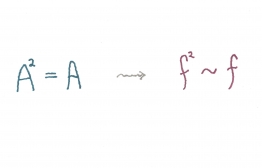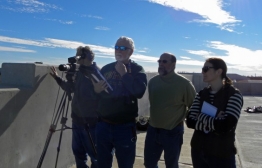As a Loyola student, you have the opportunity to work alongside our talented professors to partner in collaborative research. Learn more about some recent research and projects currently underway.
The Fortress Historical Trajectories Series, General Editor: Denis Janz
Religious Studies’ Professor Denis Janz’, The Fortress Series, Historical Trajectories, is a short series of single-author books, each one sketching the historical profile of a currently discussed Christian belief, practice, or issue. It is grounded on the assumption that Christianity’s past is not only relevant and usable, but in fact imperative for all 21st century Christians who want to think responsibly, critically, and creatively about their faith. The books will answer the demand for exacting detail coupled with accessibility: These will be quick yet accurate overviews responsibly authored by senior theologians and historians of Christianity. The series draws on primary sources from the New Testament to the 21st century, and attempts to paint for us the big picture: What do the main contours of the tradition look like? Who were the key contributors, and what was the nature of their contribution? Where were the decisive turning points, the creative advances, the dead ends? In short, can a trajectory be discerned? Where have 20 centuries of reflection brought us? And finally, can anything be said about the question “where to from here?” Yes – in a sense this series aims for the impossible: Making the most sophisticated scholarship reader-friendly!
List of authors and volume titles:
Lois Malcolm, Christian Understandings of God: The Historical Trajectory
Denis Edwards, Christian Understandings of Creation: The Historical Trajectory
Veli-Matti Kärkkäinen, Christian Understandings of the Trinity: The Historical Trajectory
David Jensen, Christian Understandings of Christ: The Historical Trajectory
Tatha Wiley, Christian Understandings of Sin: The Historical Trajectory
Randall Zachman, Christian Understandings of Grace: The Historical Trajectory
Paul Avis, Christian Understandings of the Church: The Historical Trajectory
Grant Kaplan, Christian Understandings of Faith and Rationality: The Historical Trajectory
Charlene Burns, Christian Understandings of the Problem of Evil: The Historical Trajectory
Amy Johnson Frykholm, Christian Understandings of the Future: The Historical Trajectory
All of the volumes will be published in late December 2015.
Moral and Religious Emotions
Father Edward Vacek, S.J., Ph.D. recently published two new articles that address his on-going research on the topic of moral and religious emotions...
Article one: Rather than the usual attempt to base discernment in either God’s will or God’s reason, this article argues that we are given the responsibility to decide, but only within a mutual friendship with God: “Discernment within a Mutual Love relationship with God: A New Theological Foundation,” in Theological Studies volume 74, no. 3 (September 2013): pages 683-710. http://www.readperiodicals.com/201309/3060455041.html.
Article two: Religions usually focus on having right beliefs and doing right deeds. This article argues that both beliefs and deeds are founded on having the proper array of emotions: “Orthodoxy Requires Orthopathy: Emotions in Theology,” in Horizons no. 40 (2013): pages 218-41. http://preview.tinyurl.com/ndob5lp
Faculty research to be published in Mexican Math. Society journal
Dr. Michael Kelly is currently working on research in the area of topology known as Fixed Point Theory. A collaboration with Professor D. Goncalves of the University of Sao Paulo, Brasil has lead to a research article which will appear in the journal Bulletin of the Mexican Math. Society. This collaboration is ongoing and also involves a research project which is related to the graphic on the left.
Student research project exploring idempotents
Second year mathematics major Linda Hexter is currently working under the supervision of Dr. Kelly. She is working on a project exploring idempotent matrices and implications to a problem in fixed point theory regarding homotopy idempotents.
Professor and Student Collaborate on Mathematics Investigation
Professor Thibodeaux and senior student Savannah Logan '14, worked on a project to investigate relationships between derivatives and algebraic structures called zero divisors. They first derived a formula for the number of zero divisors in the set of upper triangular matrices whose entries are from some subset of the whole numbers. They then determined the rate at which this number grows as a function of the size of the matrices and the size of the subset of whole numbers. Those rates were then compared with the derivatives of those functions, as is done with marginal cost and revenue in economics. Finally, using Gronwall’s inequality, a result was presented concerning when it is appropriate to use derivatives to approximate these discrete quantities.
Humor in the Bible, a textbook for undergraduates
Having recently obtained a publisher’s contract for her manuscript “Humor in the Gospels: A Compendium of Scholarly Research on Humor Rhetoric (1863-2014)” Dr. Bednarz is planning to develop a textbook to be titled, “Humor in the Bible” with the assistance and input of her Honors students in a class of the same name. Under her guidance, students will be producing chapter materials, discussion questions, bibliographies, art, and digital quizzes. Dr. Bednarz already has a publisher interested in the results of the collaborative research project. The students will be acknowledged as authors and contributors in this work.
The Intentional Troubadour: Woody Guthrie's Travels Through the Twentieth Century
Woody Guthrie bore witness to most of the significant historical changes of the twentieth century. Born in 1912 in Okemah, Oklahoma, he entered a world where most people got around on foot or on horseback. His parents, Charley and Nora Belle, however, brought the first automobile to the tiny western town launching Guthrie along the way to becoming, like most Americans of the century, a fully mobile human being. By the end of his life Guthrie had travelled on just about every type of conveyance available from the horse and buggy to the airplane. Through his art, his songwriting, poetry, narrative prose, fiction, drawings, and paintings, Guthrie chronicled this history in some of the most memorable imagery in the history of American art. What child raised in the United States hasn't sung those memorable words about the "redwood forests" and the "gulfstream waters" in school or camp? Guthrie's approach to his art is best described in his own motto "All you can write is what you see." And he saw everything. As a young man in the 1930s, Guthrie, like many residents of the Great Dustbowl, pulled up stakes and travelled around the country like any good hobo searching for opportunities and honing his songwriting and musical skills. He walked, hitch hiked, and hopped trains weaving his way through the highways and byways of a rapidly changing country. When World War II broke out he shipped out with the Merchant Marine for several tours crossing the Atlantic in an adventure that brought him to the beachheads of Africa, Italy, France, and the British Isles. He was drafted in 1945 and served the final months of the war in the United States Army Air Corps, the precursor to the United States Air Force. His wanderings allowed him to visit all of the lower forty-eight, Europe, and Africa. And he wrote about what he saw. Guthrie's collection at the Woody Guthrie Center in Tulsa, Oklahoma alone contains over ten thousand manuscript pages of his writing including drafts of plays, novels, works of art, and the lyrics to over three thousand songs. I am mining this and other archival sources to write a history of the United States through the latter twentieth century using Guthrie's lens to look out on the people, places, political, historical, and technological changes that he witnessed firsthand and chronicled in his art. My research also includes interdisciplinary analyses of his art, and the how the themes of movement, motion, and travel infused his work and made it one of the best historical representations of twentieth-century America. From his writings about
hobos, Dustbowl refugees, workers, unions, and the vast vistas "From California to the New York Island" Guthrie's songs, poems, novels, opinion columns, drawings, and paintings depict an America (indeed a world) in transition. Generous support from the College of Humanities and Natural Sciences, Loyola's Marquette Fellowship, and the Woody Guthrie/BMI Foundation Fellowship has allowed me to begin this painstaking research. Support from the Loyola University Collaborative Scholarship Fellowship, a joint effort between the College and the University Honors Program has allowed me to invite students to collaborate with me own my project and,
in one instance, develop their own. Continued support from the O'Keefe Professorship will allow that work to continue.
Zero Divisor Graphs for Commutative and Noncommutative Rings
Zero divisors are objects that arise in one of the most abstract areas of mathematics. Surprisingly, investigators are able to study zero divisors using computational and geometric techniques. One of the geometric techniques involves diagrams called zero divisor graphs. Since 1988 there has been a plethora of articles on this topic. Dr. Thibodeaux and Dr. Tucci have published a joint paper in Communications in Algebra (Volume 42, Issue 9, 2014), “Zero Divisor Graphs of Finite Direct Products of Finite Rings,” which adds the continuing discussion on Zero divisors, and they are completing a second. Both of them are submitting papers which are co-authored with students.

MRGO-ing, Going, Gone
Documentary film, MRGO-ING, GOING, GONE, a decade in the making, reveals the backstory of the Mississippi River Gulf Outlet—the infamous and now closed 76-mile shipping channel implicated in the catastrophic flooding following Hurricane Katrina. Produced by the Loyola University New Orleans Center for Environmental Communication and e/Prime Media, it’s a story of wetlands destruction, coastal erosion, flooding, political wrangling and mismanaged public resources. A free, public screening of the documentary was held on Wednesday, Oct. 23 at 7 p.m. at the Chalmette Cinema located at 8700 W. Judge Perez Dr. The documentary premiered on New Orleans public television station WYES on October 20 and has since aired several times.
Filmmakers Bob Thomas, Ph.D., director of the Loyola Center for Environmental Communication, and Kevin McCaffrey, executive producer of e/Prime Media, interviewed more than 30 experts, including many who witnessed some of the most distressing environmental consequences of the shipping channel in St. Bernard Parish. The film also features The Lens reporter and Pulitzer Prize-winning environmental journalist Bob Marshall. Though the Mississippi River Gulf Outlet was closed in 2009, the nation could potentially spend billions of dollars repairing the damage caused by it, according to experts interviewed in the documentary.
Elucidating the mechanisms and physiological significance of rapid changes in epidermal UV-shielding in plants
Anne Barkley (Environmental Studies Minor) was awarded a Louisiana Board of Regents S.U.R.E. grant which allowed her to work under faculty mentorship of Professor Paul Barnes (Biological Sciences) to conduct a study on the effects of UV light on plant growth during the 2013-2014 academic year.









